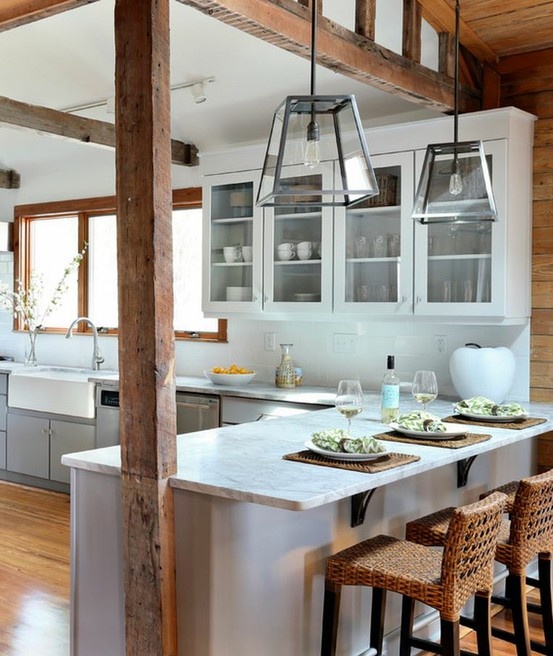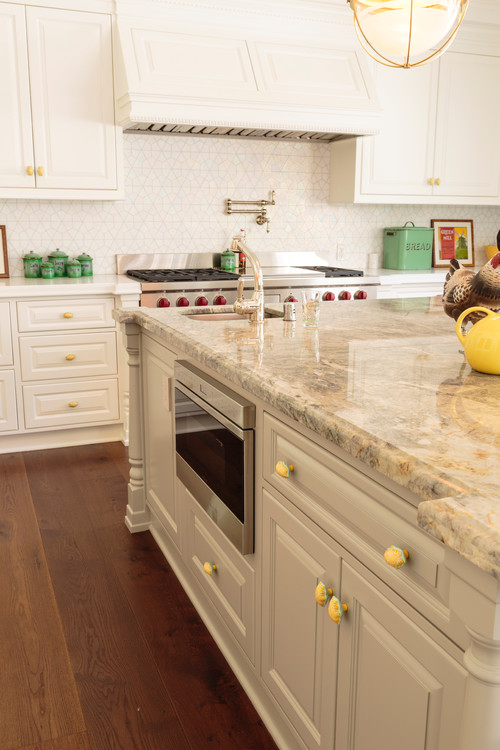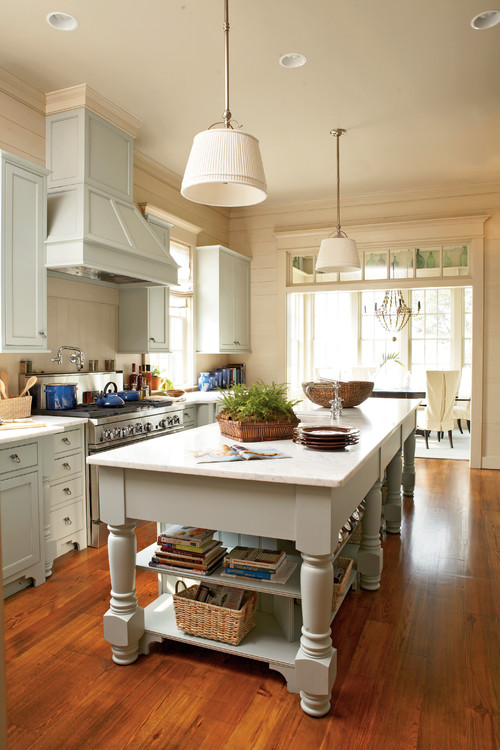Cottage style kitchens exude warmth, charm, and a timeless appeal. One of the key elements that can enhance the character and functionality of such kitchens is the kitchen island. A cottage style kitchen island not only serves as a central hub for cooking and socializing but also adds to the rustic and cozy aesthetic of the space. Today we will discuss different aspects of cottage style kitchen islands, from design inspirations and materials to functionality and maintenance.
Design Inspirations
Embracing Rustic Charm
Cottage style kitchen islands often emphasize a rustic charm that evokes the feeling of a cozy countryside home. Think distressed wood finishes, antique hardware, and reclaimed materials. The use of natural, weathered wood can add warmth and character to the island, making it a focal point in the kitchen. Incorporating open shelving and beadboard paneling can further enhance the rustic appeal.

Incorporating Vintage Elements
Vintage elements are a hallmark of cottage style kitchens. Consider incorporating vintage-inspired features such as a farmhouse sink, vintage-style faucets, and retro lighting fixtures. These elements can add a nostalgic touch to the kitchen island, creating a sense of timelessness. Using vintage furniture pieces, like an old wooden table repurposed as an island, can also add to the cottage charm.
Adding Shiplap and Beadboard
Shiplap and beadboard are popular design elements in cottage style kitchens. These features can be used to clad the sides of the kitchen island, adding texture and visual interest. Shiplap, with its horizontal wooden planks, and beadboard, with its vertical grooves, can both evoke a sense of traditional cottage style and contribute to a cozy, inviting atmosphere.

Incorporating Natural Stone Countertops
Natural stone countertops, such as marble or soapstone, can add an elegant yet rustic touch to a cottage style kitchen island. These materials offer durability and a timeless appeal that complements the overall cottage aesthetic. The natural veining and texture of stone countertops can enhance the visual interest and sophistication of the island.
Using Soft, Pastel Colors
Soft, pastel colors are often associated with cottage style kitchens. Consider painting the kitchen island in shades like soft blue, mint green, or creamy white. These colors can create a serene and inviting atmosphere, making the kitchen island a focal point that adds to the overall charm of the space. Pairing pastel colors with natural wood elements can create a balanced and harmonious look.
Incorporating Decorative Accents
Decorative accents can enhance the cottage style of your kitchen island. Consider adding corbels, turned legs, or decorative moldings to the island for an added touch of elegance. Incorporating open shelves with decorative brackets can provide both storage and display space for charming dishware and accessories. These accents can elevate the overall design and create a cohesive cottage look.

Materials for Cottage Style Kitchen Islands
Reclaimed Wood
Reclaimed wood is a popular choice for cottage style kitchen islands due to its rustic and eco-friendly appeal. Using reclaimed wood for the island can add character and a sense of history to the kitchen. This material often features unique textures, weathering, and patina, making each piece one-of-a-kind. Reclaimed wood can be used for the island’s base, countertop, or both.
Butcher Block
Butcher block countertops are a classic choice for cottage style kitchen islands. Made from strips of hardwood, butcher block provides a warm, natural look that complements the cottage aesthetic. It is also functional, offering a durable and practical surface for food preparation. Regular maintenance, such as oiling, can keep the butcher block looking its best and extend its lifespan.
Marble and Soapstone
Marble and soapstone countertops add a touch of elegance to cottage style kitchen islands. These natural stones offer unique veining and color variations that can enhance the visual appeal of the island. While marble requires more maintenance due to its susceptibility to staining and etching, soapstone is more durable and heat-resistant. Both materials can add a timeless and sophisticated look to the kitchen.

Painted Wood
Painted wood is a versatile material that can be used for both the base and countertop of a cottage style kitchen island. Soft, pastel colors or muted tones can create a charming and inviting atmosphere. Distressed or weathered finishes can enhance the rustic appeal. Painted wood allows for customization and can be easily updated to match changing design preferences.
Wrought Iron and Metal Accents
Wrought iron and metal accents can add an industrial touch to cottage style kitchen islands. These materials can be used for hardware, such as drawer pulls and handles, or as structural elements, like legs or support brackets. The combination of metal and wood can create a balanced look that blends rustic charm with modern functionality. Metal accents can also add durability and strength to the island.
Tile
Tile can be used creatively on cottage style kitchen islands, particularly for the countertop or backsplash. Hand-painted or patterned tiles can add a decorative element and a pop of color. Subway tiles or mosaic designs can contribute to the vintage and charming look of the island. Tiles are also practical, offering a durable and easy-to-clean surface.

Functional Features of Cottage Style Kitchen Islands
Ample Storage
One of the key functional features of a cottage style kitchen island is ample storage. Incorporating drawers, cabinets, and open shelves can provide essential storage space for kitchen utensils, cookware, and pantry items. Consider using wicker baskets or decorative bins to keep items organized and add to the cottage charm. Customizing the storage solutions to fit your needs can enhance the island’s functionality.
Seating Area
A seating area can transform your kitchen island into a multifunctional space. Incorporating bar stools or chairs allows the island to serve as a casual dining area, a spot for morning coffee, or a place for family and friends to gather while cooking. Choosing seating with a cottage style, such as wooden stools or chairs with upholstered cushions, can enhance the overall aesthetic.
Built-in Appliances
Integrating built-in appliances into your kitchen island can enhance its functionality. Consider including a built-in microwave, dishwasher, or wine cooler. These appliances can save space and provide convenient access to essential kitchen functions. Ensure that the design of the island accommodates the appliances seamlessly, maintaining the cottage style look.

Prep and Cooking Area
Designing the island as a prep and cooking area can enhance its utility. Incorporating a butcher block countertop, a built-in sink, or a stovetop can create a dedicated space for food preparation. Ensuring that there is ample counter space for chopping, mixing, and cooking can make the island a central hub for kitchen activities. The use of durable and heat-resistant materials can enhance the practicality of this area.
Decorative Displays
Cottage style kitchen islands often feature decorative displays that add to the charm and character of the space. Open shelves or glass-front cabinets can be used to showcase beautiful dishware, vintage kitchen tools, or decorative items. Consider incorporating hooks or racks for hanging pots, pans, and utensils. These displays can enhance the visual appeal and contribute to the cozy, lived-in feel of the kitchen.
Multi-functional Design
A multi-functional design can maximize the utility of your kitchen island. Combining elements such as storage, seating, prep space, and decorative displays can create a versatile and efficient island. Consider your specific needs and how the island can serve multiple purposes. Customizing the design to fit your lifestyle can enhance the functionality and enjoyment of the space.

Layout and Placement Considerations
Kitchen Size and Layout
The size and layout of your kitchen play a crucial role in determining the appropriate size and placement of the island. For smaller kitchens, a compact island with a streamlined design can provide functionality without overwhelming the space. In larger kitchens, a more substantial island can serve as a central focal point. Consider the flow of traffic and ensure there is enough space around the island for comfortable movement.
Work Triangle
The work triangle concept, which involves positioning the sink, stove, and refrigerator in a triangular layout, can enhance the efficiency of your kitchen. Placing the island within this triangle can provide additional prep and storage space, making it a functional part of the kitchen workflow. Ensure that the placement of the island does not obstruct the work triangle and allows for easy access to these key areas.
Accessibility and Clearance
Ensuring accessibility and proper clearance around the kitchen island is essential for a functional layout. There should be enough space between the island and surrounding cabinets or appliances to allow for easy movement and access. A minimum clearance of 36 inches is recommended, with more space needed for areas with high traffic. Consider the placement of seating and appliances to ensure they do not impede movement.

Proportion and Scale
The proportion and scale of the kitchen island should complement the overall design of the kitchen. An island that is too large can overwhelm the space, while one that is too small may not provide enough functionality. Consider the size of the room, the height of the countertops, and the overall design aesthetic when determining the appropriate scale. A well-proportioned island can enhance the visual balance and harmony of the kitchen.
Focal Point and Visual Interest
A cottage style kitchen island can serve as a focal point that adds visual interest to the space. Consider incorporating unique design elements, such as a contrasting countertop material, decorative accents, or an eye-catching color. The island can anchor the design and draw attention, enhancing the overall aesthetic of the kitchen. Positioning the island to create a focal point can elevate the visual appeal.
Lighting and Ambiance
Lighting plays a crucial role in the functionality and ambiance of the kitchen island. Incorporating task lighting, such as pendant lights or under-cabinet lighting, can provide ample illumination for food preparation and cooking. Ambient lighting, such as chandeliers or recessed lights, can enhance the overall atmosphere. Consider the style and placement of the lighting fixtures to complement the cottage aesthetic.

Maintenance and Care
Cleaning and Upkeep
Regular cleaning and upkeep are essential to maintaining the beauty and functionality of your cottage style kitchen island. Wipe down the surfaces with a mild cleaner and a soft cloth to remove dirt and grime. Avoid using abrasive cleaners or scrubbers that can damage the finish. Pay special attention to natural stone countertops, as they may require specific cleaning products and methods.
Protecting Wood Surfaces
Wood surfaces, such as butcher blocks or reclaimed wood countertops, require regular maintenance to keep them looking their best. Periodically oil the wood to prevent drying and cracking. Use cutting boards to protect the surface from knife marks and stains. Clean up spills promptly to prevent water damage and staining. Regularly check for signs of wear and address any issues promptly.
Sealing Stone Countertops
Natural stone countertops, such as marble and soapstone, may require sealing to protect against stains and moisture. Follow the manufacturer’s recommendations for sealing frequency and products. Clean up spills immediately to prevent staining, and avoid placing hot pots and pans directly on the surface. Regular maintenance and sealing can prolong the life and beauty of stone countertops.
Caring for Painted Surfaces
Painted wood surfaces on the kitchen island may require touch-ups to maintain their appearance. Use touch-up paint to cover any chips or scratches. Clean the painted surfaces with a mild detergent and a soft cloth. Avoid using harsh chemicals or abrasive cleaners that can damage the paint. Regularly inspect the surfaces for signs of wear and address any issues promptly.
Maintaining Metal Accents
Metal accents, such as wrought iron or metal hardware, may require periodic maintenance to prevent rust and wear. Clean metal surfaces with a mild cleaner and a soft cloth. Use a metal polish to restore shine and protect against tarnish. Regularly check for signs of rust or damage and address any issues promptly to maintain the durability and appearance of metal accents.
Addressing Wear and Tear
Regularly inspect your cottage style kitchen island for signs of wear and tear. Address any issues, such as loose hardware, damaged surfaces, or worn finishes, promptly to prevent further damage. Regular maintenance and timely repairs can prolong the life and functionality of the island, ensuring it remains a beautiful and integral part of your kitchen.

Common Mistakes to Avoid
Overcrowding the Space
One of the most common mistakes is overcrowding the kitchen with a too-large island. Ensure that the island fits comfortably within the kitchen layout, allowing for easy movement and access. Consider the flow of traffic and the work triangle when determining the size and placement of the island.
Ignoring the Overall Design
Ignoring the overall design and aesthetic of your kitchen can result in a mismatched and uncoordinated look. Ensure that the style, materials, and colors of the kitchen island complement the rest of the kitchen. Consider consulting with a design professional if you are unsure about the best choices for your space.
Skimping on Quality
Using low-quality materials or hardware can compromise the durability and appearance of your kitchen island. Invest in high-quality materials and craftsmanship to ensure a long-lasting and functional island. Quality materials may require a higher initial investment but can provide better value and satisfaction in the long run.
Neglecting Maintenance
Neglecting regular maintenance and care can lead to wear and damage over time. Clean and maintain the surfaces, hardware, and accents of your kitchen island regularly. Address any repairs or touch-ups promptly to keep the island looking its best and functioning properly.
Poor Lighting
Inadequate lighting can affect the functionality and ambiance of your kitchen island. Ensure that there is sufficient task and ambient lighting to illuminate the island effectively. Consider the style and placement of the lighting fixtures to complement the cottage aesthetic and enhance the overall atmosphere.
Lack of Functionality
Focusing solely on aesthetics without considering functionality can result in an impractical kitchen island. Ensure that the island provides essential features such as storage, seating, and prep space. Consider your specific needs and how the island can serve multiple purposes to enhance the utility of your kitchen.

What materials are best for a cottage style kitchen island?
Reclaimed wood, butcher block, marble, soapstone, painted wood, wrought iron, and tile are all excellent materials for a cottage style kitchen island. Each material offers unique benefits in terms of durability, maintenance, and aesthetic appeal, allowing you to choose based on your specific needs and preferences.
How do I choose the right size and placement for my kitchen island?
To choose the right size and placement, consider the size and layout of your kitchen, the work triangle, and accessibility. Ensure there is enough space around the island for easy movement and access. The island should complement the overall design and not overcrowd the space.
What are some functional features to include in a cottage style kitchen island?
Functional features include ample storage, a seating area, built-in appliances, a prep and cooking area, decorative displays, and a multi-functional design. These features can enhance the utility and versatility of the kitchen island, making it a central hub for kitchen activities.

How do I maintain and care for my cottage style kitchen island?
Maintain and care for your kitchen island by cleaning it regularly, protecting wood surfaces, sealing stone countertops, caring for painted surfaces, maintaining metal accents, and addressing wear and tear promptly. Regular maintenance and timely repairs can prolong the life and functionality of the island.
What are some common mistakes to avoid when designing a cottage style kitchen island?
Common mistakes to avoid include overcrowding the space, ignoring the overall design, skimping on quality, neglecting maintenance, poor lighting, and lack of functionality. Ensuring that the island fits well within the kitchen layout, complements the design, and provides essential features can help avoid these mistakes.
How can I incorporate vintage elements into my cottage style kitchen island?
Incorporate vintage elements by using vintage-inspired features such as a farmhouse sink, vintage-style faucets, retro lighting fixtures, and repurposed furniture pieces. These elements can add a nostalgic touch and enhance the cottage charm of your kitchen island. Vintage decor and accessories can also contribute to the overall aesthetic.

Related Posts: